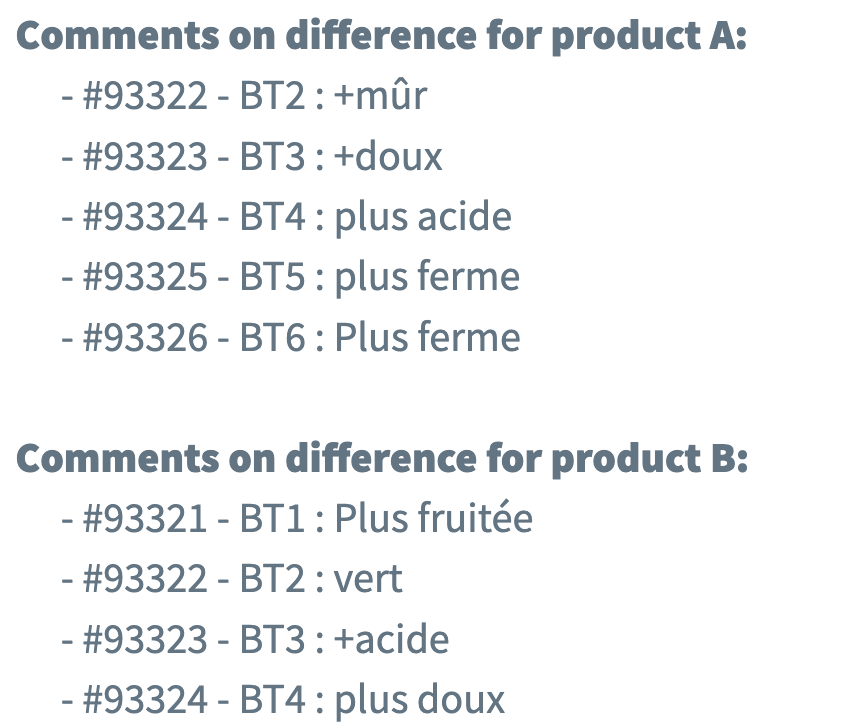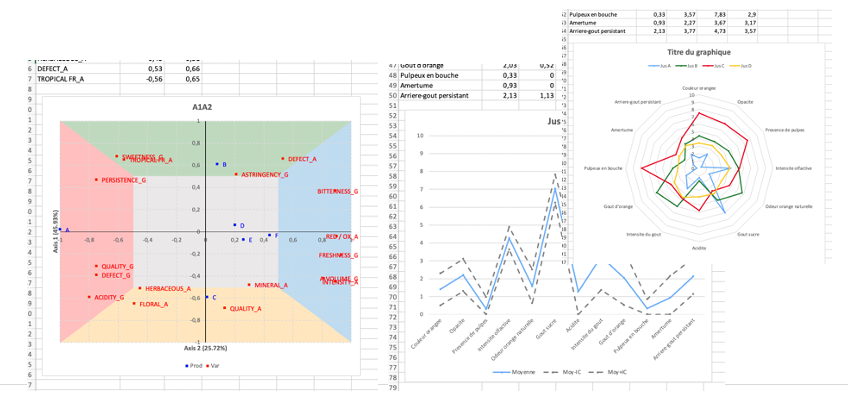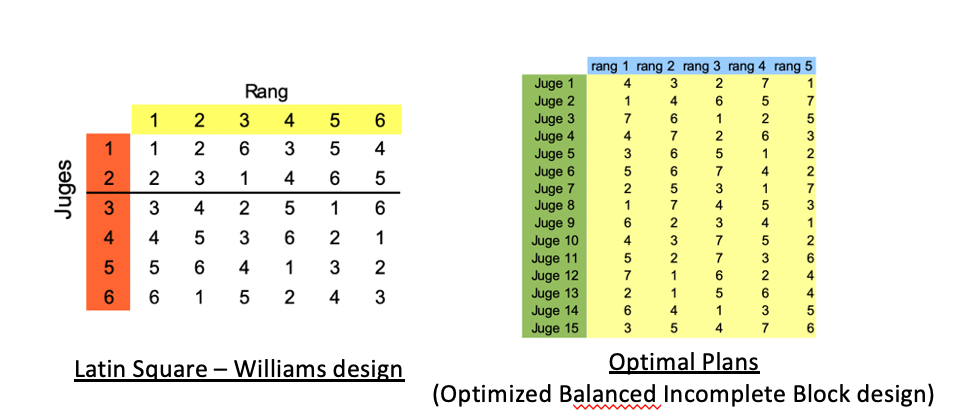TASTELWEB® : on the triangles, things are moving !
New features for a historic test on Tastelweb® and...a must !
#1: (optional) Insertion of a question of preference
This option allows you to give your preference between the 3 samples presented. In the results a significance is given.


#2: (optional) Intensity of the difference
This question already exists. It is now optional.
A legend, below the axis, has been added.



#3: (optional) Display of results to the panelist
This display has become an option.
- right or wrong answer (already existing)
- unique product number (new)

#4: Description of products
It is possible to add comments :
- on the single product (already existing)
- on the other two products (new)
In the summary results, possibility of
reveal the names of the panelists, authors of the comments.



#5: Calculation of the number of samples to be planned
In the running order of samples : it is possible to find the number of samples to be prepared by anonymity code (to facilitate the preparation of the service).
#6: Beta risk : choice in the degree of requirement
It is now possible to choose the rate of differentiators.
25% remains the default %.

#7: Export raw data in Excel format
This export of raw data makes it possible to have a quick overview of the correct / incorrect answers (without having to enter in the test management in each tasting form for each panelist).

2023 OBJECTIVES : others improvement points identified, now available!
Work collaboratively
#1: SaaS Structure
This option allows :
- The existence of an administrator in the company who will be able to manage the opening and closing of user accounts
- Access to a common workspace, with a common database, which allows collaborative work between collaborators.
This option is to be requested from your usual contacts at Tastelweb®.
A new way to connect
#2: SSO connection (“Single Sign-On”)
Access to the Tastelweb® software will be simplified for users belonging to large companies.
The SSO option allows a user to access several computer applications (including Tastelweb®) by simply
a single authentication.

Structural changes
#3: Modifications to the management of the system to bring more comfort of use
- Conversion library change : this change will make it possible to better convert the results into the current report formats (in pdf, in word).
- Switch to a more powerful server : greater capacity, greater speed of execution.
- A new test space :
the latter, with greater capacity, will make it possible to better involve customers in the "testing" of future key functionalities.

2023 - 2024 OBJECTIVES : to meet your new needs, new features and tests are still being prepared by our IT team!
A new test to come :
#1: The Qualitative profile.
The Qualitative profile remains a method very suitable for products that are essentially evaluated on olfactory perceptions ; this new test differs from the classic/QDA profile by these two major differences :
1/ The descriptors are qualitative in nature with intensity progessions based on tick marks with a label, instead of being based on quantified intensity scales.
2/ The processing is based on counts, and therefore depends on the occurrences of each of these ticks instead of the averages from the intensity scales.
3/ Automated communication is possible with internal Information Systems (ERP, SAP, ID Systems, Oracle...).

Textual analysis
#2: implementation on QDA (classic tests - descriptors with intensity scales) and on Napping (Map Profile).
As a reminder :
Tastelweb® makes it possible to process totally free expression !
Based on comments or, for example, defects or qualities requested in free text from the panelists, the frequencies of the most important qualifiers can be identified and calculated by product, almost automatically.
These results make it possible to describe and compare the products with each other in a completely open way, without these terms having been suggested beforehand to the panellists.


Profile Pivot©
#3: Bring additional information into the results.
1/ CFA : visualization of the significance of descriptors
2/ Improve the results in the case of different phases :
- to be able to filter first of all, during the extraction of the data (either on all the phases, or phase by phase), in order to be able to constitute specific dictionaries by phase, if necessary.
- title the phase name
in the results.


Classic Profile / QDA
#4: Better visualization of the scorecard / questionnaire
1/ Names of limits or milestones not truncated
2/ Definition with an exact note scale for each limit
3/ Neutral Wallpaper, replacing the one with the characters
4/ "Sample N°" optimization in "No..." uniquely
5/ Bolding
the number of the sample being evaluated

General
#5 : Improvement of the database.
1/ The creation of a section dedicated to test models
2/ Suggested comments : saved in the database


General
#6 : Other new features.
1/ Processed results : reports to Excel format !
2/ Products, descriptors : creation of a unique key UUID
- Unique, non-falsifiable key (respecting confidentiality)
- Possible modification of sample codes, labels
- Possible history tracking
- Panel performance : repeated products without the bias of the same code
3/ Project, brand : creation of these 2 concepts :
- a test can be linked to a project
- one sample to one brand
4/ New product presentation plans :
- Latin Square - Williams design
- optimal plans (Optimized Balanced Incomplete Block design)
5/ Evaluation sheet, questionnaire in paper version, printable
6/ Addition of panelists during the session



New tests
#7 : Quality & Product Compliance
This test will cover product conformity assessments realized on industrial sites ; today these tests are carried out by few people, on paper or Excel spreadsheets.
- Entries by ticks – Counting frequencies of occurrences
- Synthesis results possible by consent

New tests
#8 : Ranking
Ask the panelists to make a classification of products, from best to worst, in general; from the strongest to the weakest, on such and such a criterion...
this is currently possible through a QDA/classic profile.
The project would be make it more immediate the configuration and access to the results of this classification.

New tests
#9 : Discriminative test - 2 out of 5
In the context of non-saturating products, this alternative test to the triangular test proves more robust decreasing the risk of finding the unique product by chance (10% Vs. 33%).

New tests
#10 : The Expert profile
The Expert profile, as its name suggests, will allow to send more complete questionnaires to expert panelists.
There will be the possibility, for the same test, of mix descriptive profiles with intensity scales with various questions (open questions, multiple choice, cross tables, etc.).

New tests
#11 : The Flash profile
This rapid test will complete the offer of our tests in Tastelweb®.
Main characteristics :
- free entry of discrimination axes
- entering rows for each product on these axes
- graphic representations : PCA…








